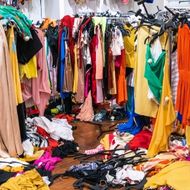What Is Sustainability?
The U.S. is the third-most populated country in the world, yet we’re responsible for a disproportionate amount of greenhouse gas emissions, pollution, consumption and waste. If everyone in the world lived the way Americans do today, it would take five Earths to sustain the planet.
Sustainability is not just about having enough resources for human beings – it’s about sharing the planet and creating a livable future for all of us inhabiting the Earth.

12 Ways to Live More Sustainably
Every day, we make choices in our lives that affect the environment, the climate and wildlife. From what we eat to how many children we decide to have, there’s a lot we can do to “choose wild” and reduce our environmental footprint to leave more room for wild animals and plants.
The Fashion Industry and the Climate Crisis
The fashion industry can no longer sit on the sidelines of the climate and extinction crises. Read our two reports on the fashion industry - Shear Destruction: Wool, Fashion and the Biodiversity Crisis (with Collective Fashion Justice's CIRCUMFAUNA Initiative) and At What Cost? Unravelling the Harms of the Fast Fashion Industry.
Secondhand 101
Climate change, biodiversity loss and pollution are being driven in part by people’s ever-growing use of materials. More than half of all greenhouse gas emissions are embodied in the things we consume. That’s why secondhand represents an essential tool for shifting our use of materials and building a world where humans and wildlife can thrive.
Simplify the Holidays
Simplify the Holidays challenges people to question the mindless drive to shop and refocus the season on what really matters to you and your family. Simplifying the holidays doesn’t mean you have to stop giving your loved ones gifts. It’s about seeking meaningful, wildlife-friendly alternatives. And often these alternatives are more memorable, unique and economical than mass-produced items found in big box stores.
In 2013 the Center expanded our population program to encompass overconsumption and sustainability. These issues are intricately tied to the impact of human population growth on endangered species and the health of our planet. With more than 7.5 billion people living here — and another 227,000 added every day — our demands for land, water, food and fossil fuels, paired with our immense amounts of waste and pollution, are driving climate changes and pushing other species to extinction.
The Center is bringing animals, plants and the health of our planet back into the sustainability conversation. We’re taking on the systems in the United States that cause the most environmental damage (with a focus on the livestock and energy industries) and asking people to “choose wild” — to live in a way that allows wildlife and wild lands to thrive. Together we can stop the rampant overconsumption that threatens the future of other species as well as our own.
Population vs. Sustainability — What’s to Blame?
Population and sustainability are part of the same equation, adding up to the single-largest threat to biodiversity: human impact. If we all reduce our environmental footprint without addressing human population growth, our sheer numbers will continue to push other species out. If we slow population growth without getting rampant overconsumption under control, the planet will continue to be stripped of the resources needed by other species — and us — to thrive.
Rather than continuing to debate whether population growth or overconsumption is more to blame for today’s environmental challenges, we need to address both. Panthers, sea turtles and thousands of other species being pushed to the brink of extinction every day depend on it.











